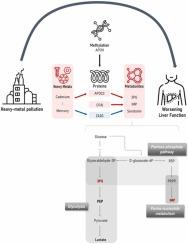当前位置:
X-MOL 学术
›
J. Hazard. Mater.
›
论文详情
Our official English website, www.x-mol.net, welcomes your
feedback! (Note: you will need to create a separate account there.)
Heavy metal exposure and its effects on APOC3, CFAI, and ZA2G
Journal of Hazardous Materials ( IF 12.2 ) Pub Date : 2024-11-20 , DOI: 10.1016/j.jhazmat.2024.136574 Nam-Eun Kim, Min Heo, Hyeongyu Shin, Ah Ra Do, Jeeyoung Kim, Hee-Gyoo Kang, Sora Mun, Hyun Ju Yoo, Mi Jeong Kim, Jung-Woong Kim, Chul-Hong Kim, Young-Seoub Hong, Yong Min Cho, Heejin Jin, Kyungtaek Park, Woo Jin Kim, Sungho Won
Journal of Hazardous Materials ( IF 12.2 ) Pub Date : 2024-11-20 , DOI: 10.1016/j.jhazmat.2024.136574 Nam-Eun Kim, Min Heo, Hyeongyu Shin, Ah Ra Do, Jeeyoung Kim, Hee-Gyoo Kang, Sora Mun, Hyun Ju Yoo, Mi Jeong Kim, Jung-Woong Kim, Chul-Hong Kim, Young-Seoub Hong, Yong Min Cho, Heejin Jin, Kyungtaek Park, Woo Jin Kim, Sungho Won

|
Despite increasing heavy metal pollution, traditional epidemiology often fails to link exposure to health outcomes. This study used multi-omics to investigate associations between heavy metal exposure and health. Blood and urine samples from 294 participants in heavy metal-exposed and control areas were analyzed, revealing key biomarkers. Meta P analysis revealed consistent trends in apolipoprotein C3 (APOC3) expression, and mediation analysis showed significant effects of APOC3 and zinc-alpha-2-glycoprotein (ZA2G) on metabolites: the mediating effect of APOC3 from blood cadmium to serotonin was 0.023 (P<0.001) and that to 3-phosphoglyceric acid (3PG) was 0.0125 (P=0.002). Mendelian randomization confirmed the positive impact of APOC3 and Complement Factor I (CFAI) and the negative effect of ZA2G on metabolites, with apolipoprotein H (APOH) methylation significantly altering APOC3 (β=−0.22, P=0.017), CFAI (β=0.176, P=0.035), and ZA2G (β=0.139, P=0.048) protein levels. Liver function variables, including albumin, total protein, calcium, and lactate dehydrogenase, correlated with 3PG and serotonin levels in the exposed areas. Sex-specific analysis showed that men exhibited stronger compensatory mechanisms via CFAI and myo-inositol, while women’s greater vulnerability to heavy metal exposure highlighted the need for targeted interventions. These findings suggest APOH methylation affects APOC3, CFAI, and ZA2G levels, elevating 3PG, inosine monophosphate, and serotonin levels and harming liver function via lipolysis, supporting the use of these markers in health monitoring, therapies, and policies to limit heavy metal risks.
中文翻译:

重金属暴露及其对 APOC3、CFAI 和 ZA2G 的影响
尽管重金属污染日益严重,但传统的流行病学往往无法将暴露与健康结果联系起来。本研究使用多组学来调查重金属暴露与健康之间的关联。分析了重金属暴露区和对照区 294 名参与者的血液和尿液样本,揭示了关键生物标志物。Meta P 分析显示载脂蛋白 C3 (APOC3) 表达趋势一致,介导分析显示 APOC3 和锌-α-2-糖蛋白 (ZA2G) 对代谢物的显著影响:APOC3 从血镉到 5-羟色胺的介导作用为 0.023 (P<0.001),对 3-磷酸甘油酸 (3PG) 的介导作用为 0.0125 (P=0.002)。孟德尔随机化证实了 APOC3 和补体因子 I (CFAI) 的积极影响以及 ZA2G 对代谢物的负面影响,载脂蛋白 H (APOH) 甲基化显着改变了 APOC3 (β=−0.22,P=0.017)、CFAI (β=0.176,P=0.035) 和 ZA2G (β=0.139,P=0.048) 蛋白水平。肝功能变量,包括白蛋白、总蛋白、钙和乳酸脱氢酶,与暴露区域的 3PG 和 5-羟色胺水平相关。性别特异性分析表明,男性通过 CFAI 和肌醇表现出更强的代偿机制,而女性对重金属暴露的脆弱性更大,这凸显了针对性干预的必要性。这些发现表明 APOH 甲基化影响 APOC3、CFAI 和 ZA2G 水平,升高 3PG、肌苷单磷酸和血清素水平,并通过脂肪分解损害肝功能,支持在健康监测、治疗和政策中使用这些标志物以限制重金属风险。
更新日期:2024-11-20
中文翻译:

重金属暴露及其对 APOC3、CFAI 和 ZA2G 的影响
尽管重金属污染日益严重,但传统的流行病学往往无法将暴露与健康结果联系起来。本研究使用多组学来调查重金属暴露与健康之间的关联。分析了重金属暴露区和对照区 294 名参与者的血液和尿液样本,揭示了关键生物标志物。Meta P 分析显示载脂蛋白 C3 (APOC3) 表达趋势一致,介导分析显示 APOC3 和锌-α-2-糖蛋白 (ZA2G) 对代谢物的显著影响:APOC3 从血镉到 5-羟色胺的介导作用为 0.023 (P<0.001),对 3-磷酸甘油酸 (3PG) 的介导作用为 0.0125 (P=0.002)。孟德尔随机化证实了 APOC3 和补体因子 I (CFAI) 的积极影响以及 ZA2G 对代谢物的负面影响,载脂蛋白 H (APOH) 甲基化显着改变了 APOC3 (β=−0.22,P=0.017)、CFAI (β=0.176,P=0.035) 和 ZA2G (β=0.139,P=0.048) 蛋白水平。肝功能变量,包括白蛋白、总蛋白、钙和乳酸脱氢酶,与暴露区域的 3PG 和 5-羟色胺水平相关。性别特异性分析表明,男性通过 CFAI 和肌醇表现出更强的代偿机制,而女性对重金属暴露的脆弱性更大,这凸显了针对性干预的必要性。这些发现表明 APOH 甲基化影响 APOC3、CFAI 和 ZA2G 水平,升高 3PG、肌苷单磷酸和血清素水平,并通过脂肪分解损害肝功能,支持在健康监测、治疗和政策中使用这些标志物以限制重金属风险。


















































 京公网安备 11010802027423号
京公网安备 11010802027423号